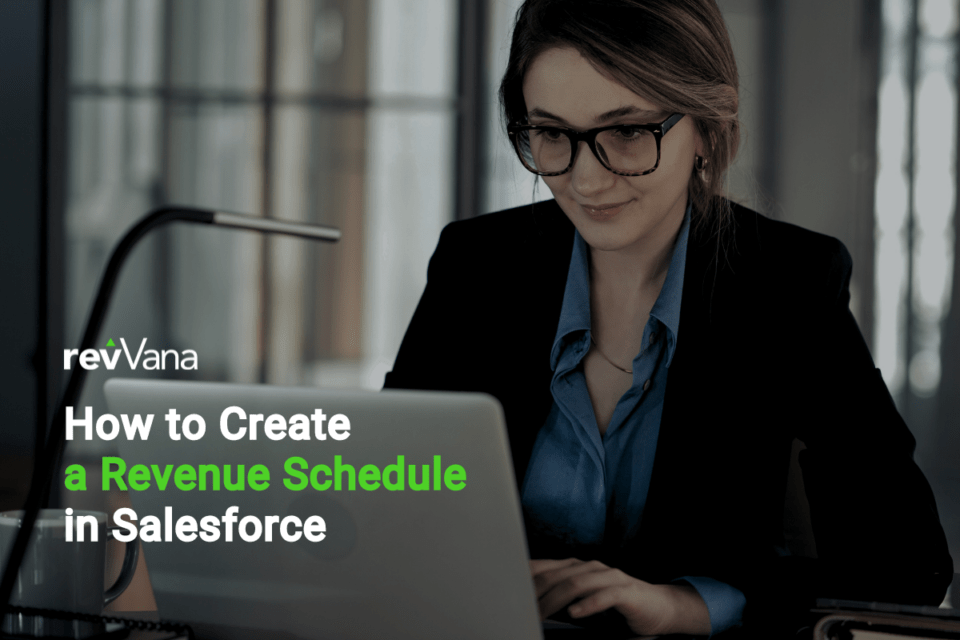

What Is Revenue Operations (RevOps) and Why Is It Important?
Learn about Revenue Operations (RevOps) as a strategy to align siloed revenue teams within B2B and B2C companies and unify revenue goals and targets.

Published on Friday, May 5, 2023
Revenue forecasting is crucial for any business, as it helps ensure that deals closed by the sales department result in revenue. Salesforce is one of the most popular platforms used by organizations for revenue forecasting, but it can be a complicated and challenging task, especially if you’re unfamiliar with how to create a revenue schedule in Salesforce.
In this article, we will provide a step-by-step guide on how to create a revenue schedule in Salesforce, starting with an overview of Product Schedules, the Salesforce tool used to manage revenue forecasting. Additionally, we will detail how to use revVana to optimize your Salesforce revenue forecasts, providing real-time insights on CRM data to help you make smarter, data-driven decisions.
Salesforce’s Product Schedules is a tool that allows you to create, manage, and analyze revenue forecasts, and it is the focus of our guide on how to create a revenue schedule in Salesforce. With this tool, you can see a quantity schedule, which shows when a product should be delivered, a revenue schedule that shows when a product will be paid for, and a default schedule that is linked to a specific offering in your organization.
Using Salesforce’s Product Schedules brings various benefits to your organization, including simplified planning and management of cash flow, the ability to manage payments and see the full revenue of Opportunities, and heightened visibility of both your committed and forecast revenue streams. By choosing the best type of schedule for your organization, you can make the most out of this powerful tool and optimize your revenue forecasts.

Creating a revenue schedule in Salesforce is a complex process that involves several steps. In this section, we provide a step-by-step guide on how to create a revenue schedule in Salesforce.
The first step in creating a revenue schedule in Salesforce is to determine the type of schedule needed. Depending on your business needs, you may need a revenue schedule, a quantity schedule, or a default schedule. It is important to choose the right type of schedule to ensure accurate revenue forecasting.
The next step is to set up Product Schedules in Salesforce. This involves going to the setup menu, then clicking Build, then Customize, then Product Schedules Settings. You will then need to check the boxes of the types of schedules that you want to use. For revenue forecasting, you click revenue schedules. Then click Save.
The next step is to forecast revenue at the opportunity stage. This involves connecting Products to Opportunities in Salesforce. All that needs to be done is that the sales rep must select the necessary product and click “save”. Using revVana Plan, you can create forecasts at any sales level from your CRM data. The revenue scheduling engine automatically creates forecasts at the account, opportunity, or any other sales level. You are able to set rules for how and when to build forecasts.
After you have connected Products to Opportunities, you need to establish a schedule for payment and delivery. This involves inputting relevant details such as when revenue will be received for the product, how frequently it will be received, and the number of months you expect to receive it. This step is not difficult if you have already enabled Product Scheduling in the setup menu.
After you save the schedule for payment and delivery, you will be redirected to a pre-built schedule. This page will show you revenue amounts equally spread out across the fixed time-period that you set out in the previous step. Here, you will be able to tailor any specifics that you want. Using revVana Plan, you can translate forecasts in your pipeline and closed opportunities into forecasts of revenue streams automatically. This reduces the possibility of human error, increases accuracy, and saves time.
Once you have established a schedule for payment and delivery of the first product, you will need to repeat the process for every product associated with the opportunity. The process is the same for each product, including selecting the correct products, establishing a schedule for payment and delivery, and creating customized schedules and forecasts.
After you have established revenue schedules for all products on the opportunity, you can create reports and dashboards to analyze revenue. Salesforce allows you to create custom reports and dashboards that provide visibility into your revenue streams and help you make informed decisions about your business.

Accurate revenue forecasting is crucial for businesses to make data-driven decisions and achieve success. However, inaccurate revenue forecasts can lead to missed opportunities and significant financial losses. If your business is using Salesforce for revenue forecasting, it is essential to ensure that you are creating revenue schedules accurately and efficiently. Failure to do so can result in missed revenue targets and poor financial planning.
Fortunately, revVana provides a solution to this problem. With revVana, you can automate revenue forecasting, integrate with Salesforce for real-time data, and reduce manual errors. revVana Plan allows you to create accurate revenue forecasts at any sales level from your CRM data, automatically creating forecasts at the account, opportunity, or any other sales level. You can set rules for how and when to build forecasts, ensuring that you have a clear understanding of your revenue streams.
Don’t let inaccurate revenue forecasts hinder your business’s growth and success. Contact revVana today to learn more about how revVana Plan can help you optimize your revenue forecasting in Salesforce and achieve your business goals.